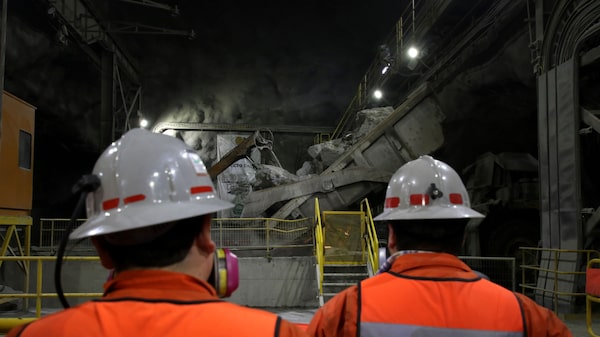A roundup of Wednesday’s stock market results from across the Americas
👑 Peru leads in Latin America:
Peru‘s S&P/BVL (SPBLPGPT) gained 0.83% to lead Latin America’s gains, followed by Colombia’s COLCAP (COLCAP), which closed 0.81% higher.
Peru’s market was buoyed by the shares of Enel Generación Perú S.A.A. (ENGEPEC1) and Alicorp S.A. (ALICORC1), which rose 6.14% and 3.60%, while Colombia’s COLCAP got a boost from the shares of Banco de Bogotá (BOGOTA), which gained 7.72%, and Canacol Energy (CNEC), which rose 7.09%.
The Colombian stock market rose despite the fact that business confidence in October fell to 17% compared to September, the lowest figure since August 2020, while industrial confidence fell to -0.4%, a result not seen since May 2021, in the same time period, according to figures from Fedesarrollo.
Mexico’s S&P/BMV IPC (MEXBOL) and Argentina’s MERVAL (MERVAL) gained 0.45% and 0.25%.
📉 A bad day for Chile’s IPSA:
Chile’s Ipsa (IPSA) was the worst performer on Wednesday, retreating 0.64%, a fall driven by the real estate and communication services sectors. The shares of Parque Arauco S.A. (PARAUCO) slid 3.48% and those of Empresas CMPC S.A. (CMPC) fell 3.01%.
Chilean copper producer Codelco said Wednesday it will reduce refined copper shipments to China next year after prolonged interruptions at its smelters and strong demand elsewhere, according to Bloomberg. The Chilean mining giant will reduce shipments to annual contract customers by 2023 by around 10%.
Brazil’s Ibovespa (IBOV) had a slight setback of 0.18% during the day, disassociating itself from the results of Wall Street and awaiting the possible impact of the fiscal management of the incoming government of President-elect Luiz Inácio Lula da Silva.
🗽 On Wall Street:
US stocks ended Wednesday’s session higher after the Federal Reserve’s latest meeting minutes showed most officials backing slowing the pace of interest-rate hikes soon.
The S&P 500 and the Nasdaq 100 notched gains for a second straight session. Treasuries rallied, with the benchmark 10-year yield around 3.69%. Wall Street’s fear gauge, the Cboe Volatility Index, fell to its lowest level in more than three months. US stock and bond markets will be closed on Thursday for the Thanksgiving holiday.
The Nasdaq Composite (CCMPDL) and the S&P 500 gained 0.99% and 0.59% respectively, while the Dow Jones Industrial Average climbed 0.28%.
Several Fed officials backed the need to moderate the pace of rate hikes, the central bank’s Nov. 1-2 meeting minutes show. Only a small number of these officials underscored the need for a higher terminal rate. Since the Fed’s latest meeting, investors have parsed a bevy of economic data that somewhat eased inflation concerns, further strengthening the case for smaller rate hikes.
“The minutes were dovish as they recognized a softening in consumer demand and tightening international economic and financial conditions,” said Jay Hatfield of Infrastructure Capital Management.
Still, some investors think that the meeting minutes didn’t convey anything new and that markets may be overreacting to the perceived shift in tone.
“The minutes said that hikes can be smaller than 75bps but also that the terminal rate will need to be higher than previously thought -- which also is pretty much what everyone at the Fed has been signaling anyway,” said Max Gokhman, chief investment officer at asset manager AlphaTrAI.
“It’s almost weird we’re getting any kind of big moves on the minutes. I guess the market is happy to take a longer road to a more painful outcome given the reaction to the minutes.”
Meanwhile, the dollar dropped for a second day as investors assessed a fresh batch of economic data. Business activity in the US continued to contract and separate data showed US unemployment applications rising more than expected, in a sign of cooling in the labor market.
On the currency markets, the Bloomberg Dollar Spot Index fell 0.8%, the euro rose 1% to $1.0402, the British pound rose 1.5% to $1.2065, and the Japanese yen rose 1.2% to 139.50 per dollar.
🔑 The day’s key events:
Oil dropped, with both benchmarks down almost 4% as the oil market continues to weaken in the last few days, amid the negotiations of sanctions on Russian crude and the advance of Covid-19 in China.
On Wednesday, WTI crude oil for January delivery fell 3.72% to $77.94 per barrel, while the Brent reference for January settlement had a 4.10% drop with a price of $84.74 per barrel.
“The effectiveness of price caps as a mechanism to tighten the screws on Russia remains a big question for the market,” explained Michael Tran, analyst at RBC Capital Markets, on the price range proposed by the European Union, which would be above Russia’s cost of production, and higher than what some countries are already paying for this oil.
In addition, China’s Covid-19 advance continues to hit demand from the country as it pushes for more restrictions. There were 28,183 new infections nationwide on Tuesday, up from 27,307 on Monday and just shy of the record 28,973 reached in April.
🍝 For the dinner table debate:
The loss of nearly $300 billion in market value in just 2 months has generated a growing chorus of Tesla Inc (TSLA) analysts who say the drop has gone too far.
Morgan Stanley (MS) analyst Adam Jonas said Wednesday that the company’s share price is approaching its $150 bearish scenario, offering investors a chance to buy it at a bargain price. Meanwhile, analysts at Citi (C) today upgraded their weighting on the stock to neutral from sell, saying the 50%-plus loss this 2022 “has balanced the near-term risk/reward ratio.”
Although demand has slowed and prices have declined in China, Tesla is the only electric vehicle company covered by Morgan Stanley that produces earnings from marketing its vehicles, Jonas wrote in a note. He also underscored the company’s potential when it comes to receiving benefits from U.S. consumer tax credits, and maintained his price target at $330.
Sebastián Osorio Idárraga, a content producer at Bloomberg Línea, and Emily Graffeo and Vildana Hajric of Bloomberg News, contributed to this report.



